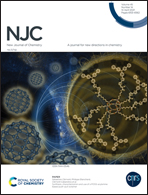The fabrication composite material of bimetallic micro/nanostructured palladium–platinum alloy and graphene on nickel foam for the enhancement of electrocatalytic activity
Abstract
A composite of bimetallic micro/nanostructured palladium–platinum (Pd–Pt) alloy, reduced graphene oxide (rGO) and polydopamine (PDA) on three-dimensional nickel foam (NF) was obtained by chemical immersion method and anneal method for ethanol electrocatalysis. The key points of the synthesis method are employing PDA as an adsorbent of graphene oxide (GO), rGO with a high specific surface area as the carbon carrier of the Pd–Pt alloy after annealing, and NF as the secondary substrate. Scanning electron microscopy revealed that Pd–Pt particles with dendrite-like micro/nanostructure are well dispersed on the surface of rGO, which provide a great deal of catalytic sites. The structure and phase characterization were determined by X-ray diffraction. The diffraction peaks of bimetallic catalysts are shifted in comparison with those of two monometallic catalysts, which prove the formation of the Pd–Pt alloy. The lattice strain and electronic effect of Pd–Pt alloy micro/nanostructured particles lead to the improvement of the electrocatalytic properties of materials. In the electrochemical measurement, the composite of the Pd–Pt alloy with appropriate atomic ratio, rGO, PDA and NF (Pd6Pt@GPN) provided the largest electrochemically active surface area and the highest peak current density with significantly enhanced cycling stability in the forward scan toward EOR in alkaline medium among all catalysts prepared. Thus, this Pd6Pt@GPN catalyst highlights the potential application in the anode catalyst of a direct ethanol fuel cell.



 Please wait while we load your content...
Please wait while we load your content...